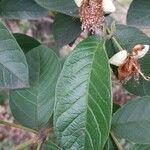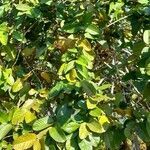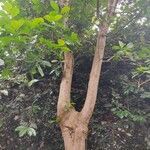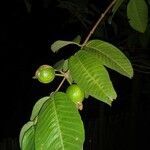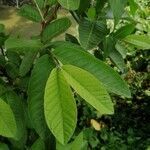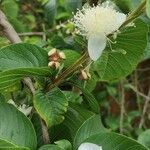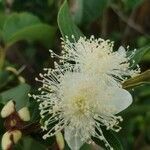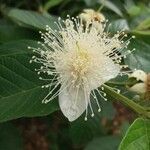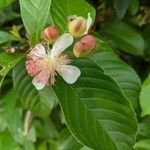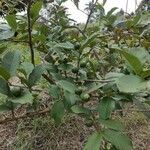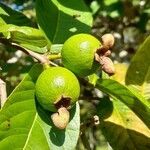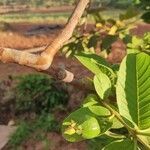A small tree or shrub 8-10 m high. It is evergreen. It has smooth bark which is mottled. The bark peels off in smooth flakes. The plant branches close to the ground. The branches are four angled. Trees are shallow rooted. The leaves are opposite, dull green and somewhat hairy. They are oval and somewhat pointed at both ends. They are 15 cm long by 2-5 cm wide. The leaves have short leaf stalks. The flowers are white and showy and borne in loose irregular types of arrangements of one to three flowers. The petals are 1.5 to 2 cm long. Both self and cross pollination occurs due to insects. The flowers grow in the axils of leaves on new growth. The fruit are rounded and 4 to 5 cm long. They are green but turn yellow when ripe. The outer covering is firm and encloses a pink or nearly white sweet smelling edible pulp. This contains many seeds. It better selected varieties both the skin and the seeds are fully edible. Fruit vary from very acid to very sweet.
Shrub or small tree to 8 m high. Branchlets/young shoots 4-angled, ± appressed or spreading pilose-pubescent. Leaves with petiole 3–10 mm long; lamina elliptic to elliptic-oblong, (4–) 7–13 (–15.5) cm long, (3.5–) 4–6 (–7.5) cm wide, rounded at base, entire, obtuse to rounded at apex, ± coriaceous, appressed-pilose when young (especially below), becoming glabrous (especially above), dotted with numerous glands; lateral veins prominent, 10–14 (–20) on each side of midrib, impressed above, raised below. Flowers usually solitary (occasionally 3 together); pedicel 1–2.5 (–3) cm long. Calyx 7–10 (–15) mm long, pubescent, splitting irregularly. Petals elliptic to obovate, 10–20 mm long, white or cream. Fruit globose, ellipsoidal or ovoid to pear-shaped (pyriform), 3–10 cm long, cream or yellow, downy at first; flesh cream or yellowish to pink, sweet. See also Zich et al. (2020).
Shrub or small tree to c. 3 m high. Trunk smooth, light brown. Shoots quadrangular, densely hairy. Petiole 5-10 mm long. Lamina 8-14 × 4.5-7 cm, oblong-elliptic to obovate-elliptic, densely hairy at first, especially on veins below, becoming glabrous above at maturity, abundantly dotted with glands beneath, ± rounded at either end; veins parallel and prominent, impressed above and raised beneath. Fls solitary; pedicels densely hairy, c. 1 cm long, with 2 subulate bracteoles c. 3 mm long. Hypanthium c. 5 mm deep, campanulate, densely hairy; calyx limb splitting into 4-5, prominent, hairy, glandular, lobes 7-8 mm long. Petals 10-13 mm long, elliptic, white, glandular-punctate. Stamens mostly slightly < petals. Style c. 1 cm long. Fr. globose or subglobose, 3-4 cm diam., becoming yellow; flesh pink, sweet. Seeds numerous.
Small tree to 12 m tall; bark pale brown or copper-coloured, thin, smooth, flaking off to reveal greenish layer beneath.. Leaves elliptic to oblong-elliptic, 7–15 cm long, 3–5(–7) cm wide, rounded or acute at the apex, rounded at the base, densely pubescent beneath; lateral nerves 12–20 pairs, parallel, prominent beneath.. Flowers axillary, solitary or in small clusters; calyx completely enclosing the young bud; lobes 9 mm long, 5 mm wide, reflexed in open flower, whitish tomentellous inside.. Petals white, oblong-elliptic, 1.3 cm long, 8 mm wide.. Stamens ± 250, ± 1 cm long.. Style ± 1 cm long, slightly capitate at the apex.. Fruit light yellow with a pink or crimson blush, globose, ovoid or pyriform, 5–10 cm long with granular flesh, juicy central white or red pulp and numerous very hard seeds 3 mm long.
Trees, to 13 m tall. Bark gray, smooth, peeling in strips. Branchlets angular, pubescent. Petiole ca. 5 mm; leaf blade oblong to elliptic, 6-12 × 3.5-6 cm, leathery, abaxially pubescent, adaxially slightly rough, secondary veins 12-15 on each side of midvein and usually impressed, reticulate veins obvious, base rounded, apex acute to obtuse. Flowers solitary or 2 or 3 in cymes. Hypanthium campanulate, ca. 5 mm, pubescent. Calyx cap nearly rounded, 7-8 mm, irregularly opening. Petals white, 1-1.4 cm. Stamens 6-9 mm. Ovary adnate to hypanthium. Style as long as stamens. Berry globose, ovoid, or pyriform, 3-8 cm, with persistent calyx lobes at apex; flesh white or yellow; placenta reddish, well developed, fleshy. Seeds many. Fl. summer.
Small tree or evergreen shrub, 2-5(10) m high; young branches 4-angled, hairy. Leaves opposite, ovate to oblong-elliptic, apex rounded or acute, base rounded, leathery, venation impressed above, raised below, hairy below. Flowers in groups of 1-3. Petals 5, spreading, white. Stamens conspicuous, many, in many series, shorter than petals. Flowering time Oct.-Dec. Fruit green to yellow, many-seeded berries, 25-100 mm in diam., flesh white, yellow or pink, sweet, pleasantly flavoured.
Leaf-lamina up to 13 x 7 cm., elliptic or oblong-elliptic, apex rounded or acute, base rounded; lower surface densely puberulous; lateral nerves in c. 16 pairs, parallel, prominent beneath.
Small tree or shrub, up to 3 m high. Leaves opposite, veins prominent. Calyx tube prolonged above ovary, splitting irregularly at flowering time. Flowers white.
Calyx completely enclosing the young flower-bud; lobes c. 0·9 x 0·5 cm., in open flower reflexed. Ungulate, whitish-tomentellous inside.
Berry up to 10 cm. long, globose, ovoid or pyriform, usually yellow, with white, yellow or crimson flesh.
Bark smooth, pale brown, peeling over large areas; branchlets quadrangular.
Style c. 1 cm. long, slightly capitate at apex.
Petals c. 1·3 x 0·8 cm., oblong-elliptic.
Flowers white, solitary, axillary.
Small tree up to 10 m. tall.
Stamens c. 1 cm. long.
